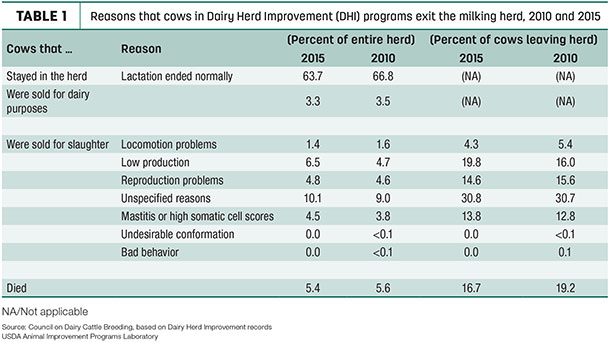With a turnover rate of about one-third of the U.S. dairy herd annually, dairy records can help identify reasons why cows leave the milking herd. The Council on Dairy Cattle Breeding (CDCB) provides one such snapshot of why cows leave Dairy Herd Improvement (DHI) herds.
CDCB produced its annual report, “Reasons that Cows in DHI Programs Exit the Herd,” analyzing records from 2015. The report is authored by CDCB staff members H. Duane Norman, technical advisor and industry liaison; L. M. Walton, technical applications manager; and João Dürr, chief executive officer.
Data is compiled from records made available through the courtesy of those U.S. dairy producers who are enrolled in DHI herd management programs.
For purposes of this article, Progressive Dairyman also compared the 2015 results to those from five years earlier (see Table 1).
The general overview shows the percentages of cows remaining in the U.S. herds for another lactation, those sold for dairy or slaughter, and cows that died. The 2015 estimates were based on about 3.97 million DHI individual cow records from 39,161 DHI herds; 2010 estimates were based on 3.66 million cow records from 41,735 herds.
A secondary approach was to calculate all percentage only from the cows that were sold for slaughter or died, to emphasize more clearly the ranking of reasons they left the herd. The rate and reason for culling can also provide beneficial information for economic studies on dairy management.
The 2015 estimates are based on about 1.3 million DHI individual cows from 30,148 DHI herds; 2010 estimates are based on 1.07 million cows from 31,877 herds.
Compared to 2010, the percentage of cows staying in the herd for another lactation in 2015 was down slightly, from 66.8 percent in 2010 to 63.7 percent in 2015. (Additionally, a small percentage of cows remaining in the herd had pregnancies ending in abortion – 0.4 percent in both 2010 and 2015.)
A similar percentage of cows (3.5 percent and 3.3 percent, respectively) were sold for dairy purposes each year. Death rates were also similar, at 5.6 percent and 5.4 percent.
Termination codes
When it comes to cows sold for slaughter, DHI records list a variety of “termination codes,” allowing dairy farmers to identify health events or other reasons cows left the herd. All Dairy Records Processing Centers (DRPC) include termination codes on each lactation record before forwarding to the national dairy database. They include locomotion problems, low production, reproductive problems, mastitis or high somatic cell scores, undesirable conformation or bad behavior, as well as death. Annual fluctuations are likely impacted by milk and feed prices, and how aggressive dairy herd managers cull.
Questions still remain regarding exactly why dairy cows leave the herd, since dairy producers cite “unspecified reasons” as one of the most frequently used categories in the termination code list. In the 2015 reports, the reason nearly 31 percent of all cows left the herd was not specified.
After “unspecified,” low production was the next most frequent code assigned across all herds, followed by reproduction problems and mastitis/high somatic cell scores.
In addition to the numbers detailed here, the annual report breaks out data by parity and breed, including crossbreds.
Clear differences across parity are evident for all breed groupings. Holstein cows sold for mastitis/high somatic cell scores increased from 2 percent in the first lactation to 9.3 percent in the sixth lactation. Similarly, the percentage of Holstein cows sold for slaughter rose for all reasons as the cows advanced in age.
Read the report, including data by parity and breed. PD

-
Dave Natzke
- Editor
- Progressive Dairyman
- Email Dave Natzke





